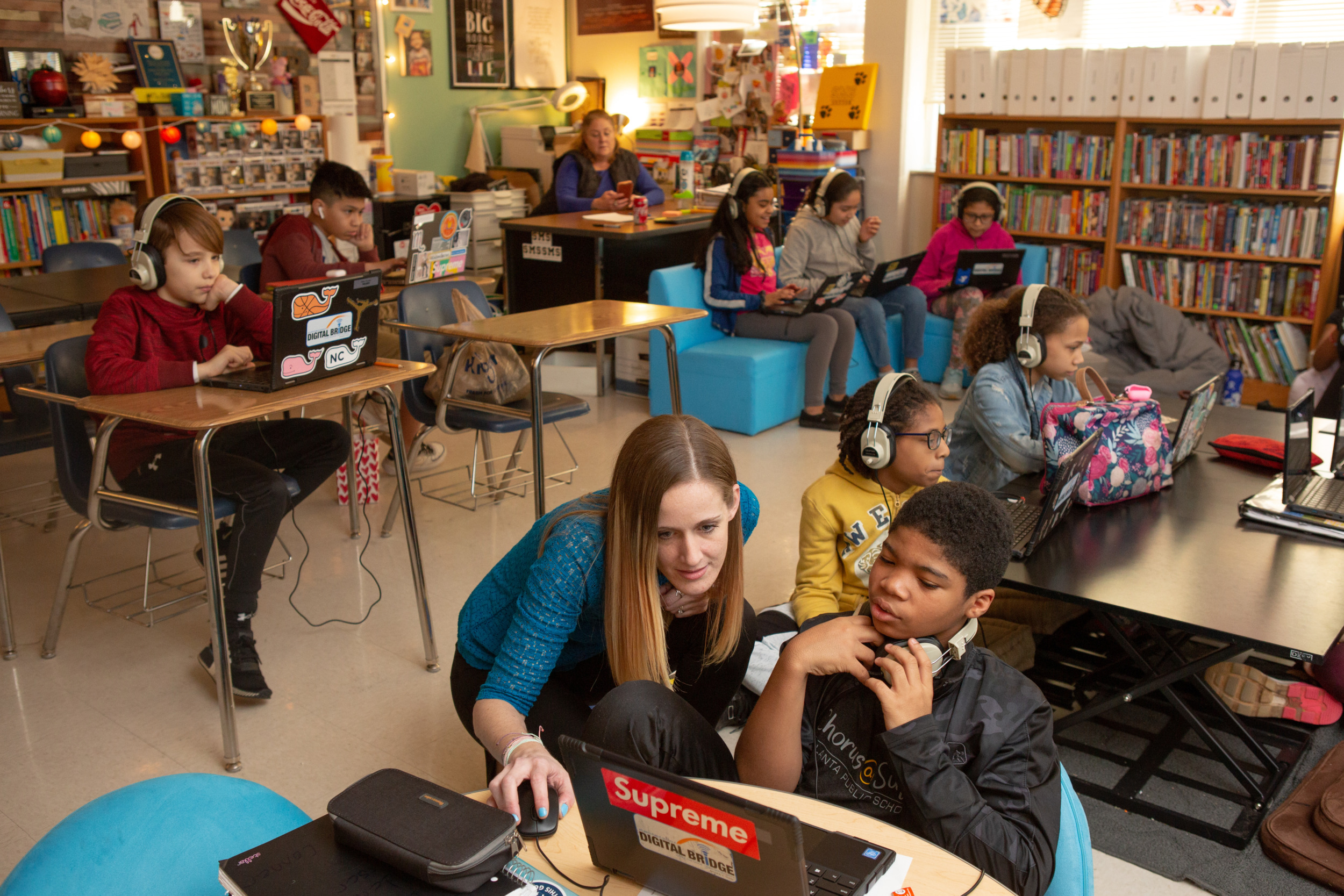This story was originally published by Chalkbeat. Sign up for their newsletters.
When pests started attacking plants in the community garden across the street from M. Agnes Jones Elementary School in Atlanta, the students hatched a plan.
They didn’t want to use pesticides in the garden, and they had learned in their science lessons that bats eat insects. They researched how to attract bats to the garden, made paper sketches of bat house designs, then moved to digital design tools. The students could see 3-D versions of their houses, test modifications, and refine their designs — making the entrance narrower so bats would feel safe and adding rafters to create better spaces for brooding.
A new National Education Technology Plan released this week urges educators to use technology to enable this kind of engaged, hands-on learning and urges states and districts to provide the training, planning time, and technical support to make it happen.
First issued by the U.S. Department of Education in 1996 and last updated in 2017, the National Education Technology Plan provides guidance to help school systems use technology to improve learning and close achievement gaps.

Drazen Zigic/Shutterstock
Technology has the potential to help students take more control of their learning, make connections they couldn’t make before, and showcase their skills in new ways.
The latest iteration comes as virtual learning and federal pandemic relief “expedited the proliferation of technologies and connectivity on a scale and speed for which many districts and schools were unprepared.” Innovation actually slowed even as more students got laptops, and too much technology use today is essentially passive, the plan argues.
Surveys suggest more than 90% of secondary students and more than 80% of elementary students have access to a personal laptop or tablet — before the pandemic, fewer than half of students had such access. Schools are awash in digital tools and grappling with the implications of artificial intelligence. Yet a recent survey of more than 41,000 students found the main way students used technology in school was to take online tests and quizzes.
Wide gaps persist between digital haves and have-nots
The plan identifies three types of digital divides. There’s still an access divide — not all students have laptops or reliable internet. There’s also a use divide — some students log into Google Classroom to catch up on assignments while others produce podcasts and design top-notch bat houses. And finally there’s a design divide — only some teachers have the training, support, and planning time to learn how to use new technology in exciting ways.
School systems need to address all three divides to make full use of technological opportunities, the plan said. They also need to balance student privacy with responsible oversight, imbue students with digital literacy, battle the ills of social media, adapt to AI, and make smart decisions about which technology to invest in, according to the report.
“… educators shouldn’t feel like they have to know everything to get started.”
Aleigha Henderson-Rosser, assistant superintendent instructional technology
Technology has the potential to help students take more control of their learning, make connections they couldn’t make before, and showcase their skills in new ways, the plan says. English learners and students with disabilities, in particular, could benefit from more ways to access material and show what they’ve learned, but if schools don’t plan carefully, these students are also at more risk of being excluded, the plan says.
The plan includes dozens of examples of educators already doing this work, including from rural and high-poverty schools, along with guidelines for decision-making and missteps to avoid.
Districts where internet access is spotty shouldn’t rely on online surveys to reach parents, for example. Consider hosting monthly in-person technology nights instead and send communication in a variety of languages. Special education directors buying screen-reading programs should make sure they also work offline and that they’re compatible with the operating system installed on district laptops.
The plan includes rubrics for assessing whether ed tech programs have evidence to back their claims and suggests regular audits of which programs teachers are actually using. An Associated Press investigation last year found school districts spent tens of millions of pandemic relief dollars on ed tech with little evidence it worked.
David Miyashiro, superintendent of the Cajon Valley Union School District in California, served on the technical working group that helped develop the report. He was an early proponent of embracing technology in education, and he’s led an expansion in Cajon Valley, where two-thirds of students come from low-income households and one-third are learning English.
“… if you want to solve the technology divide, keep giving schools money for technology.”
John Fredericks, high school English teacher
Students get their first laptops in kindergarten and use them to deliver 30-second TED talks about what they’re afraid of and what they’re excited about, illustrated by generative AI. They’re learning presentation and communication skills while building community and connection with their classmates, Miyashiro said.
Students trade up in third grade, when they go to middle school, and again for high school. An ed tech bond helped pay for devices, IT infrastructure, and a replacement fund.
Miyashiro hopes the new federal plan helps districts incorporate technology thoughtfully. And he said it feels timely, now that many more students have devices.
“A lot of districts bought computers so teachers could Zoom synchronously with their kids,” he said. “Now what are they going to do? This plan helps them course correct.”
But for John Fredericks, an English teacher at West Tallahatchie High School in the Mississippi Delta, digital access has actually gotten worse since 2021. Pandemic relief money meant students had laptops and hotspots for the first time ever — though the connections could be spotty.
“The best thing, when the students had access to the internet and a computer at home, was the ability to differentiate, the ability to challenge the kids who want more work,” Fredericks said. “And for students who have trouble completing work, I could give them more time and grace.”
[Related: 7 AI trends that could reshape education in 2024]
Now the hotspots are gone, laptops have to stay at school, and when a student is out sick, Fredericks is back to sending home paper packets. Students who take virtual dual-enrollment classes in the school’s computer lab try to get their college coursework done during other classes.
Fredericks said it’s hard to even imagine what learning opportunities his students are missing. He just hopes policymakers don’t forget that pandemic-era laptops are already breaking down and some communities still don’t have internet, at least not at a price families can afford.
“Throwing money at the problem kind of actually worked,” he said. “That’s not always true in government policy or education policy, but if you want to solve the technology divide, keep giving schools money for technology. Let them buy computers and buy hotspots and advocate for high-speed internet in rural areas.”
Blending tech with learning takes time, vision
When Margul Retha Woolfolk started as principal at M. Agnes Jones Elementary in Atlanta, she found a state-of-the-art building where the science lab was “really a storage unit.” The school serves a high-poverty neighborhood, and students spent a lot of time drilling basic skills.
Retha Woolfolk, now an associate superintendent with Atlanta Public Schools, knew her own students had done better when lessons in core skills were coupled with hands-on projects. And she loved science. She started going to conferences, learning everything she could, and seeking out partners at local universities and in the private sector.
Jarvis Blackshear, a paraprofessional with a background in music production, would come to play a critical role providing instructional support in science and technology. He had learned how to teach himself new programs as a music engineer, and he had a knack for bringing students and parents along with him.
“Don’t be scared to take risks, and the kids will guide you.”
Aleigha Henderson-Rosser, assistant superintendent instructional technology
Retha Woolfolk wanted to buy the school a programmable robot, but it cost more than $7,000. She could get it for $3,000 if she got it disassembled. Blackshear invited fourth and fifth graders to help him build it. He’d assemble each section ahead of time, sand down sharp edges, then disassemble it and have it waiting for students.
He took the same approach as students designed the bat houses, teaching himself design programs so he could support the students’ learning. When the 3D-printed bat houses weren’t up to snuff, he reached out to a grandparent with carpentry skills to help students make their blueprints reality.
Seven years later, Principal Robert Williams said he’s proud to continue the work. MAJ offers coding alongside art, music, and physical education. Students build electric cars and learn about force and motion, circuitry, teamwork, and the engineering design process along the way. The MAJ Rapid Racers team competes in Greenpower USA regional events, “the NASCAR of elementary school.”
Aleigha Henderson-Rosser, the district’s assistant superintendent for instructional technology, said leadership at the building level makes a big difference, but educators shouldn’t feel like they have to know everything to get started.
“Don’t be scared to take risks, and the kids will guide you,” she said. “Our kids deserve to learn like this.”
***
Erica Meltzer is Chalkbeat’s national editor based in Colorado, where she also covers the legislature and statewide education issues.
Chalkbeat is a nonprofit news organization covering public education.




























